Introduction & Specifications, Pricing and Availability
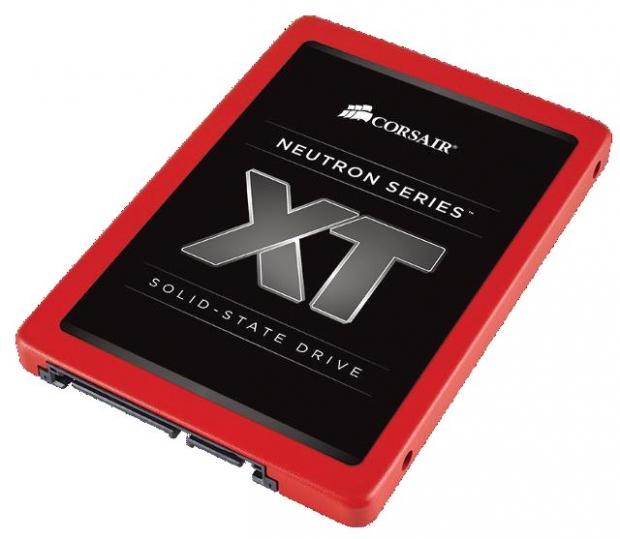
Until now, Link_A_Media Devices was the exclusive controller maker for Corsair's Neutron branded products. LAMD was acquired by SK Hynix, and since, the company has been slow to release new products to market. We suspect LAMD's slow roll out is due to Mike Lee, the Director of SSD SOC Development leaving to start Tidal Systems in May 2013. At Flash Memory Summit, we met with SK Hynix and saw several interesting products on display, but learned consumer focused controllers weren't planned for 2014.
Corsair isn't LAMD's only customer for SSD controllers, Seagate's 600 and 600 Pro also use controllers from the company. Seagate recently purchased SandForce from Avago to further both consumer and enterprise SSD products. This leads us to question if we'll ever see a viable consumer SSD from LAMD again.
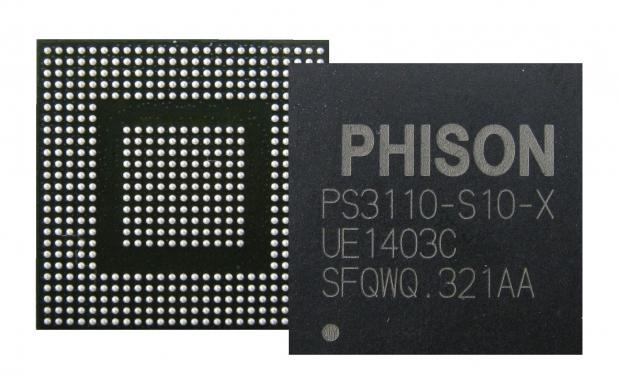
With Corsair's flagship product line stagnant, the company needed to find a new source to power a flagship SSD product. We previewed Phison's new quad-core S10 controller back in July with very early firmware. The early results were mixed, but the S10 showed a lot of potential for a product that was so early in the firmware development cycle.
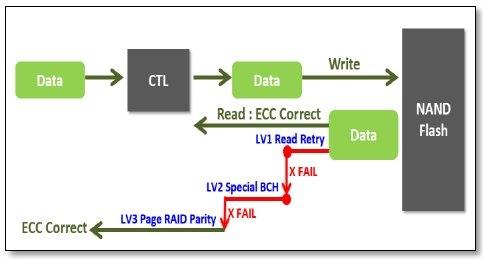
The Phison S10 controller uses a quad-core processor that dedicates three cores to flash management. Often overlooked and rarely understood, background tasks make up a majority of the controllers processing power. The faster and more efficient the background activity, the faster your front-end performance. The front-end side is what users see when opening files, transferring data and so forth. If your SOC is busy shuffling data around to manage wear, the front-end performance suffers. Some SSDs try to push back end tasks when the SSD is in an idle state or until absolutely needed, while others try to perform background tasks as soon as possible - we often call this activity aggressive garbage collection. There are pros and cons for each but with so many resources dedicated to background activity; the Phison S10 is able to reduce the amount of time needed to perform background operations.
We'll talk in depth about the new Phison S10 quad-core controller next week in a deep dive article that covers in detail all of the new advanced technology included. At this time, the firmware is final for mass production, but a few bells and whistles are yet to be enabled.
Specifications, Pricing and Availability
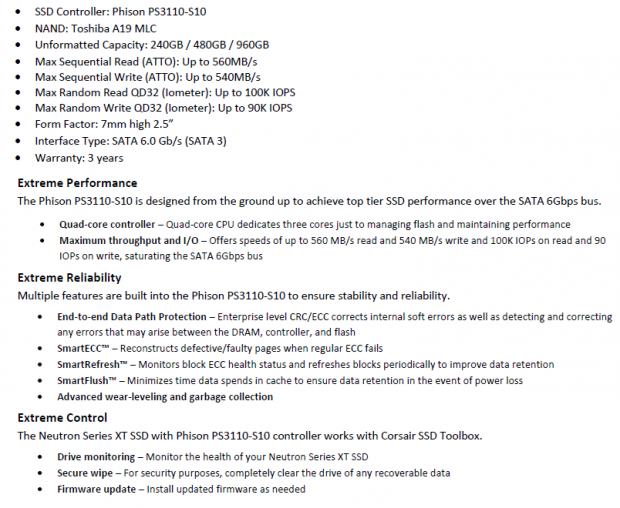
Corsair plans to release the Neutron XT in three capacity sizes: 240GB, 480GB and 960GB. Today we're focusing mainly on the largest capacity size model, but will add the two smaller capacity size drives in the some performance charts. We'll follow up this preview of the 960GB model with individual reviews of the 480GB and 240GB later this week so we can all see how the drives compare to other products in the same capacity class.
The stated performance from Corsair is 560 MB/s sequential read, 540 MB/s sequential write speeds. Random performance tips the scale at 100K random read IOPS and 90K random write IOPS. We see the 100K read IOPS mark touted often, but in our ASUS ROG Z87 test system, we have yet to break that barrier with a consumer SATA SSD... until today.
Three main points were made about the Neutron XT in our marketing material from Corsair. The first is extreme performance; the Phison PS3110-S10 was designed to compete with the fastest SSDs on the market today. The controller was actually designed for both MLC and TLC NAND flash, the latter needing more controller resources for flash management. Paired with MLC NAND flash, the Phison S10 turns into a performance beast that is capable of consistent performance under heavy workloads.
The TLC side also increases reliability for MLC flash. So many features go into keeping TLC flash reliable. Current TLC flash has around 1K P/E cycles compared to 3K P/E cycles for 1xnm and 2xnm MLC. Phison's proprietary technology designed for TLC flash endurance increases the reliability of MLC flash.
The final checkbox incorporates Corsair's SSD Toolbox software to manipulate the Neutron XT Series along with Corsair's other SSDs. You can read about the Corsair SSD Toolbox in this article that discusses all of the software features.
At this time, we don't have pricing information, but we know the Neutron XT will be available in December. The drive will ship with a five-year warranty, and a 7mm to 9.5mm spacer. As mentioned in the introduction, the firmware is nearly final, but the Neutron XT is missing support for DEVSLP / Slumber at this time. These features should be complete in the coming weeks and ship enabled in the final retail units. I think most will be surprised with the results of our Notebook Battery Life Test even without the low power states working.
Corsair Neutron XT 960GB SSD
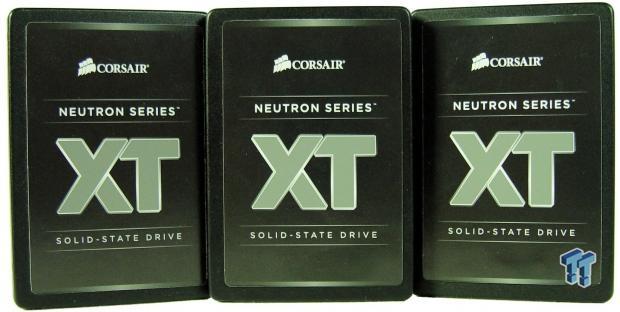
Our early samples arrived in black cases, but the final retail product coming in December will have a red case like the Force GS, also from Corsair. We have all three capacity sizes available to test, but will focus on the 960GB model in this section.


The Neutron XT uses a 7mm z-height so it will fit in notebooks and Ultrabooks that require a 7mm drive like some Lenovo T430 models.

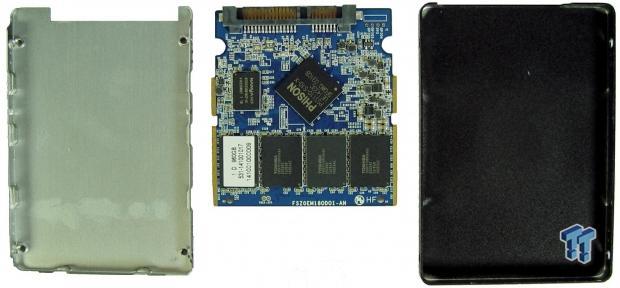
Our sample model didn't use a thermal pad to transfer heat from the controller, DRAM or flash to the case. We'll look at the heat output later in this review with our FLIR camera.
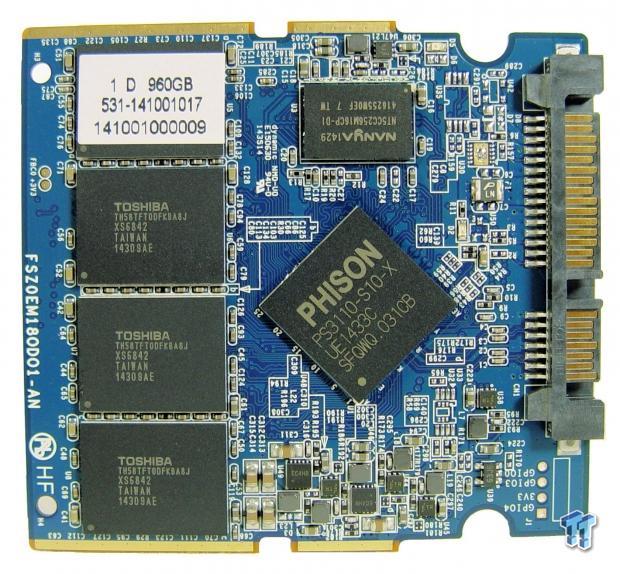
Corsair managed to stuff all 1TB of capacity in just eight NAND flash packages. This model uses two DRAM packages for buffering data, the 480BG and 240GB models use a single DRAM package for this.
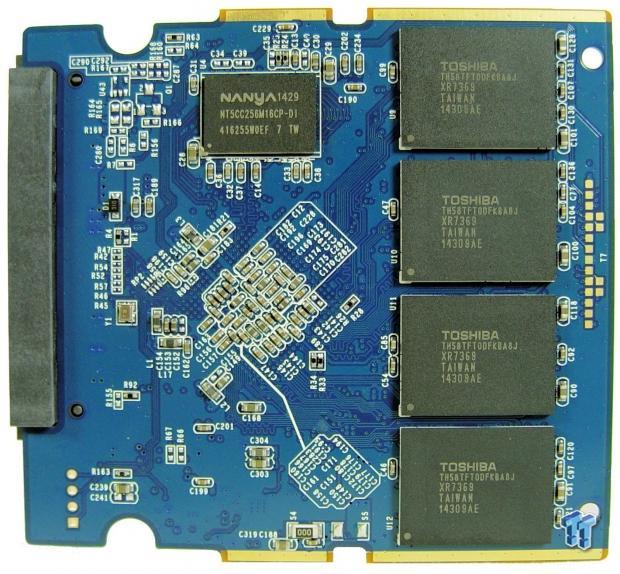
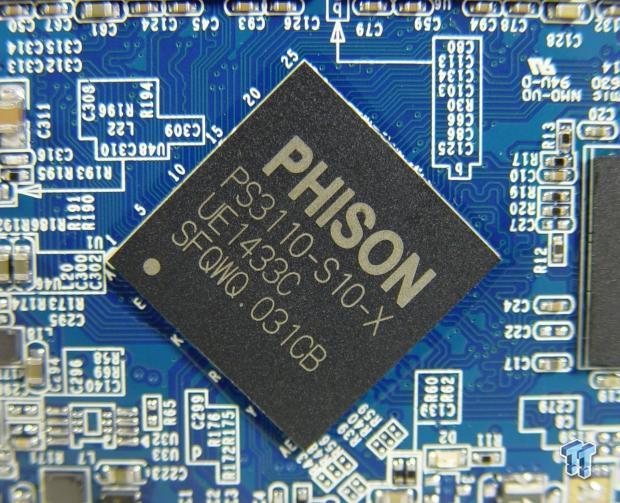
Here we get our first look at the final silicon Phison S10 controller.
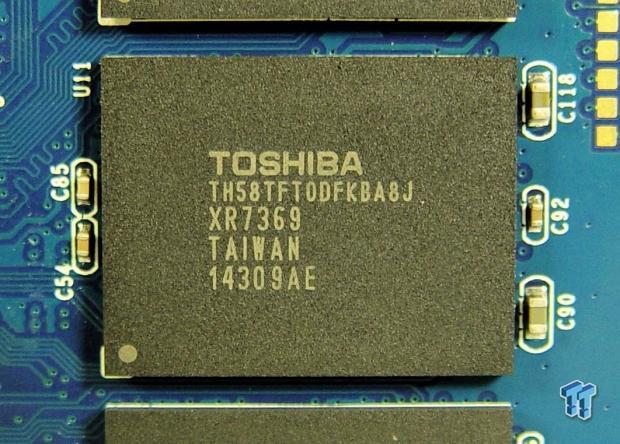
Corsair used A19, AKA second-generation 19nm Toshiba toggle flash for the Neutron XT.
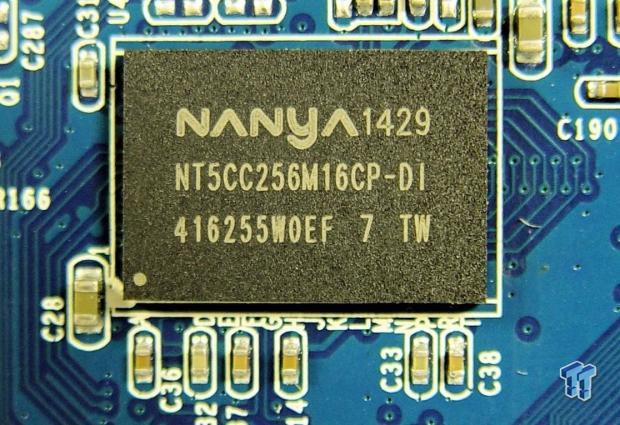
There are two Nanya DDR3 DRAM packages with 16x 256Mb die for a total of 512MB per package or 1GB of DDR3 total in the 960GB Neutron XT.
Test System Setup and Initial Performance
Desktop Test System
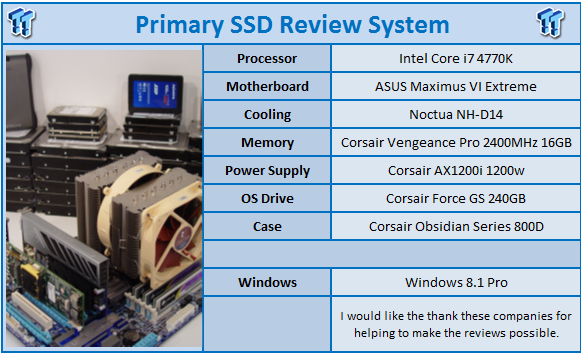
Lenovo T440 - Notebook Power Testing with DEVSLP and Windows 8.1 Pro
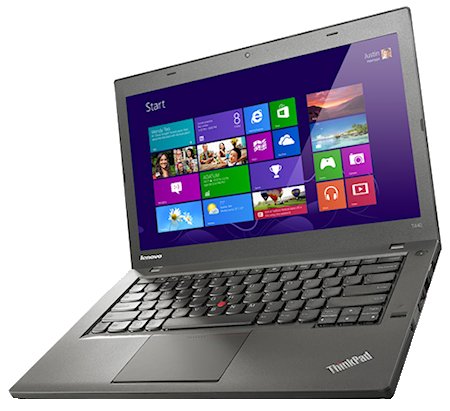
Nearly all of the performance tests run on the desktop system but we use a Lenovo T440 to run the power tests. The T440 is the latest addition to our client SSD test lab and allows us to test the notebook battery life offered by an SSD with advanced features like DEVSLP enabled.
Initial Performance Evaluation - 4-Corner and then Some Tests
Sequential Read
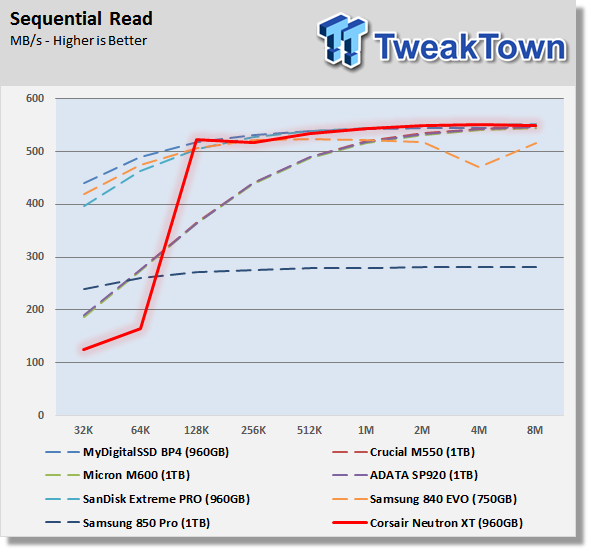
Sequential Write
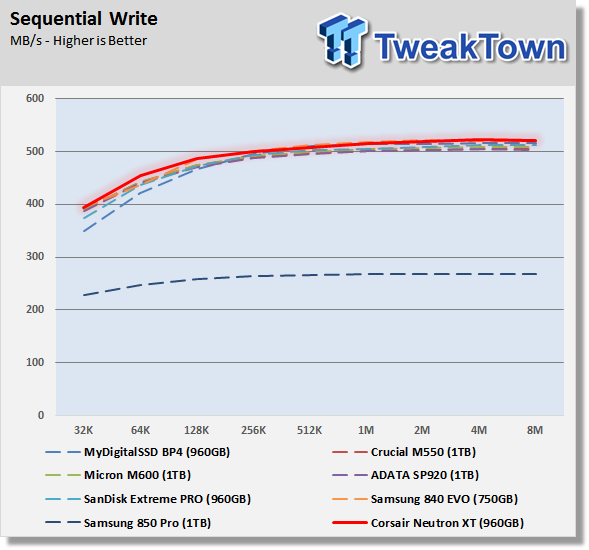
Sequential 80% Read 20% Write
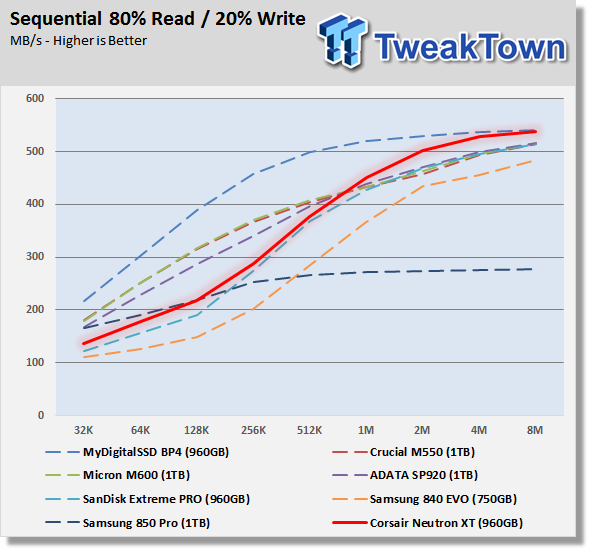
Random Read
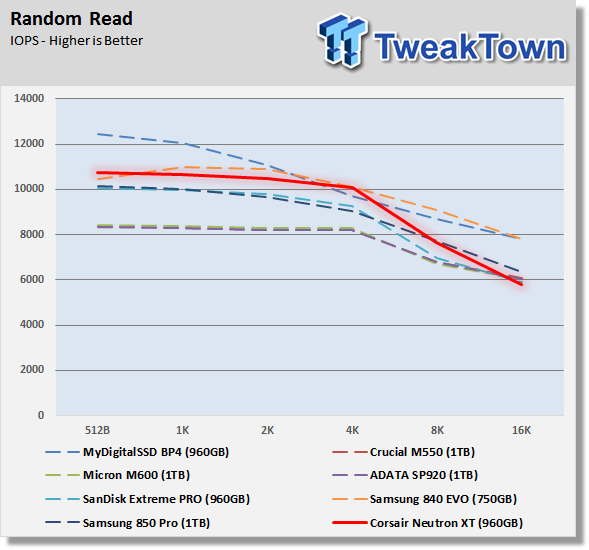
Random Write
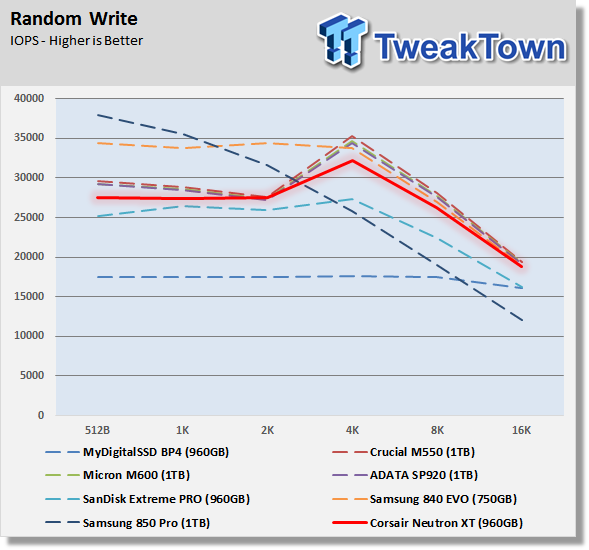
Random 80% Read 20% Write
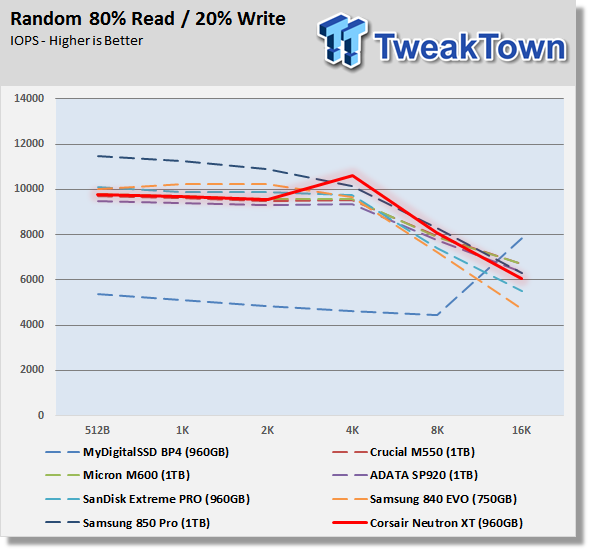
After a decade, I'm finally ready to move past ATTO to look at initial performance with different block sizes. The new tests you see above use incompressible data, a topic will talk about later in this review, and precondition the drives due to the length of each test and the order we test in. Garbage collection is active in these tests since we start with two full drive writes with sequential data before measuring performance.
The Corsair Neutron XT is represented on the chart by a red line with a slight glow. In many tests, the Neutron XT is competitive with the other products, especially the other top tier products on the market, Samsung's 850 Pro and SanDisk's Extreme PRO. Since this test actually has some preconditioning involved, the 850 Pro actually shows the worst performance in nearly every test. The 850 Pro uses very aggressive garbage collection and the background activity increases latency under the heavy workload.
Benchmarks - Sequential Performance
HD Tune Pro - Sequential Performance
Version and / or Patch Used: 5.50
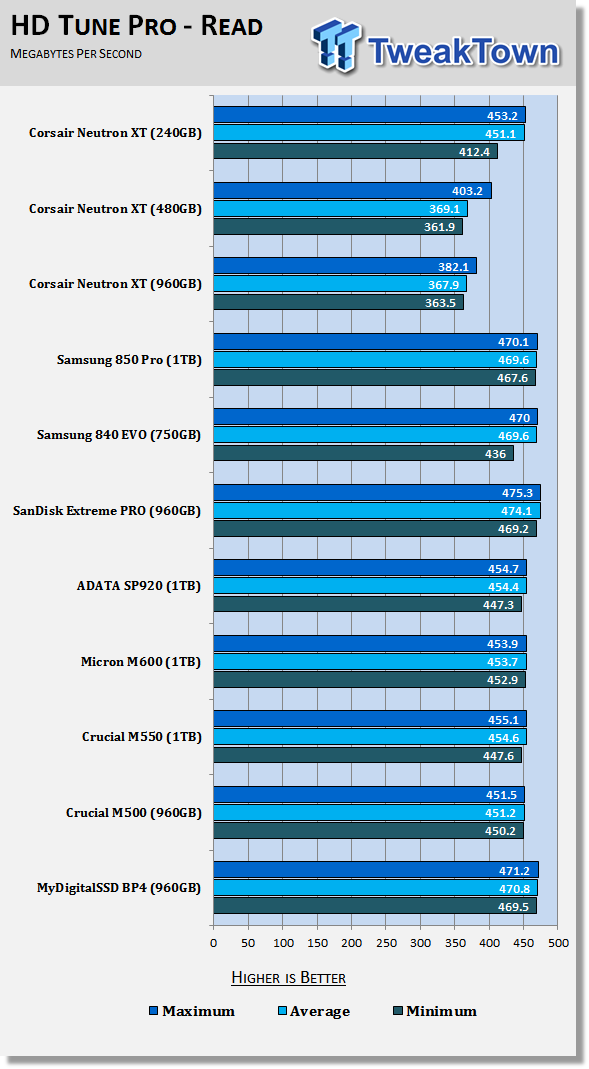
As mentioned, we're including the 240GB and 480GB Neutron XT models in this review for many of the tests. Their reviews will come later this month, possibly as early as next week. We like to compare products against others in the same capacity sizes / price ranges.
On the previous charts, we saw that the Neutron XT 960GB has lower performance at 64KB than it does at 128KB and higher block sizes. You can see that in this test with 64KB blocks to measure real-world sequential data. Some like to test with very large blocks to measure sequential performance, but rarely will a file use 8MB blocks. We're not concerned with unicorn performance in our reviews.
The Neutron XT 240GB doesn't seem to have the same issue with 64KB blocks, that model still delivers over 450 MB/s at this block size on average when reading across the user LBA range of the drive.
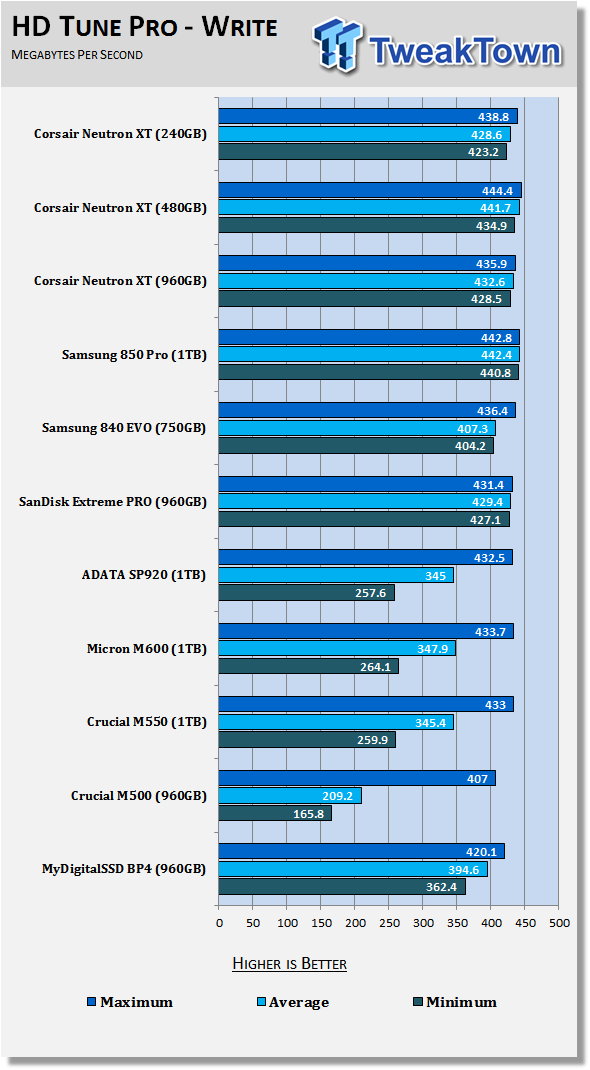
The sequential write performance is phenomenal in all three capacity sizes.
HD Tach - Sequential Write Performance after Random Writes
Version and / or Patch Used: 3.0.4.0
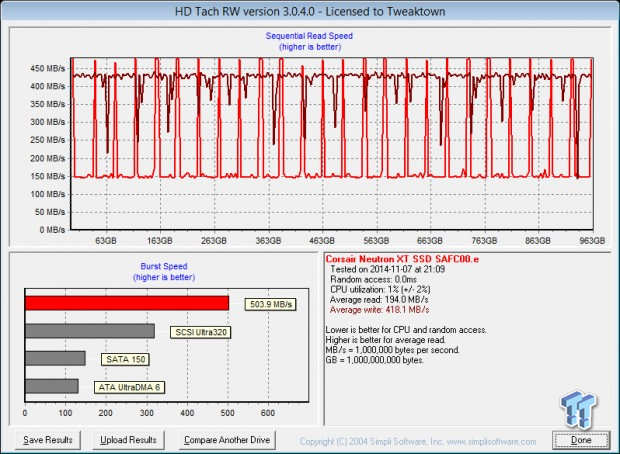
The HD Tach test that uses 128KB blocks caught us by surprise. The sequential write performance is amazing again with only a few deviations from the 425+ MB/s mark, but the sequential read performance shows low performance most of the way through. The sequential reads do spike up to nearly 500 MB/s, but those are quick bursts and not the normal level of performance.
We think the Neutron XT is using aggressive GC after the previous test and still recovering from the previous data writers. This is an area we'll explore in the future.
Benchmarks - Anvil Storage Utilities
Anvil Storage Utilities
Version and / or Patch Used: RC6
So what is Anvil Storage Utilities? First of all, it's a storage benchmark for SSDs and HDDs where you can check and monitor your performance. The Standard Storage Benchmark performs a series of tests; you can run a full test or just the read or the write test, or you can run a single test, i.e. 4k QD16.
Anvil Storage Utilities is not officially available yet, but we've been playing with the beta for several months now. The author, Anvil on several international forums, has been updating the software steadily and is adding new features every couple of months.
We can use Anvil several different ways to show different aspects for each drive. We've chosen to use this software to show the performance of a drive with two different data sets. The first is with compressible data and the second data set is incompressible data. Several users have requested this data in our SSD reviews.
0-Fill Compressible Data
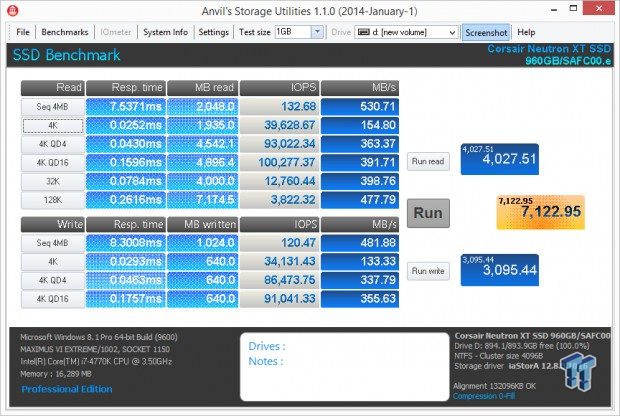
Incompressible Data
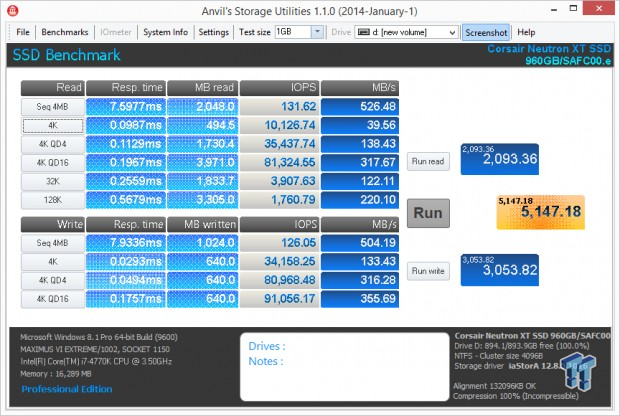
The Phison S10 controller deals with compressible and incompressible data differently, but not in the same manner we see with SandForce products. With SSDs that use the SandForce controller, the compressible performance is within reach of other products on the market and the incompressible performance is significantly lower.
The Phison S10 goes the other direction. The S10 has the same performance as other drives with incompressible data and does amazingly well with compressible data. Why do we say amazingly well, this is the first time we've breached a 7K score with any data type in this test using a consumer SATA SSD.
Low Queue Depth Read IOPS
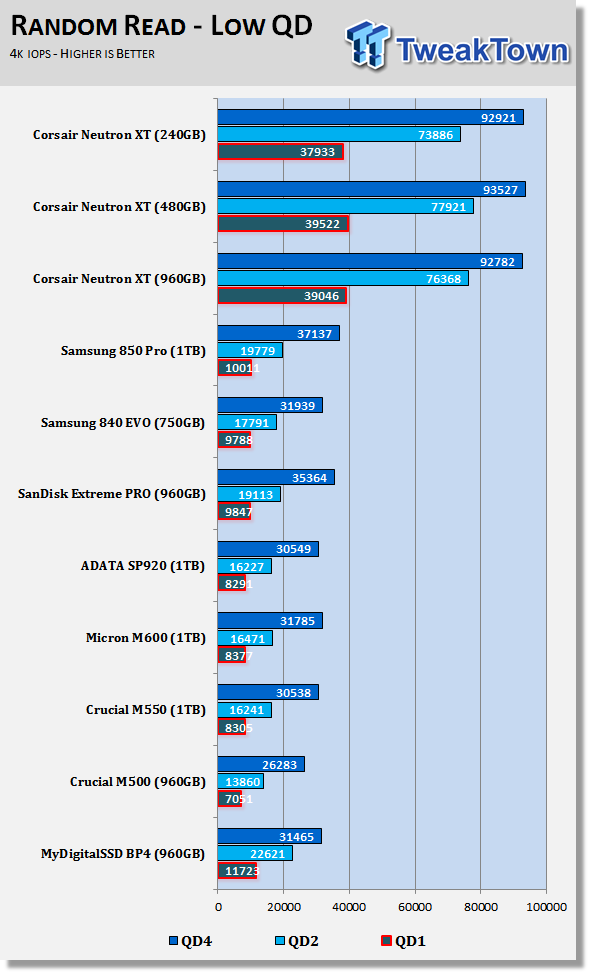
High Queue Depth Read IOPS
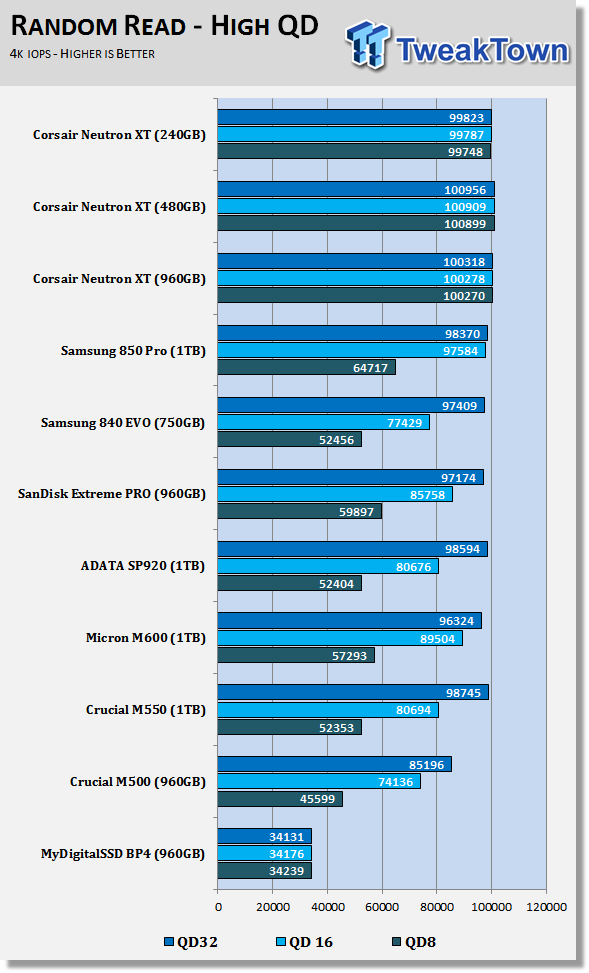
I think it's safe to say that "amazing" is the correct word choice here. We use 10K random read IOPS at queue depth 1 as the go / no-go for consumer SATA SSDs. The Corsair Neutron XT more than triples, damn near quadruples the 10K mark at QD1!
At high queue depths, the Neutron XT has already reached its peak 100K IOPS (at QD4), so there isn't much room to increase performance with SATA 6Gbps.
Compressible, Incompressible, 46% Mix Random Read IOPS
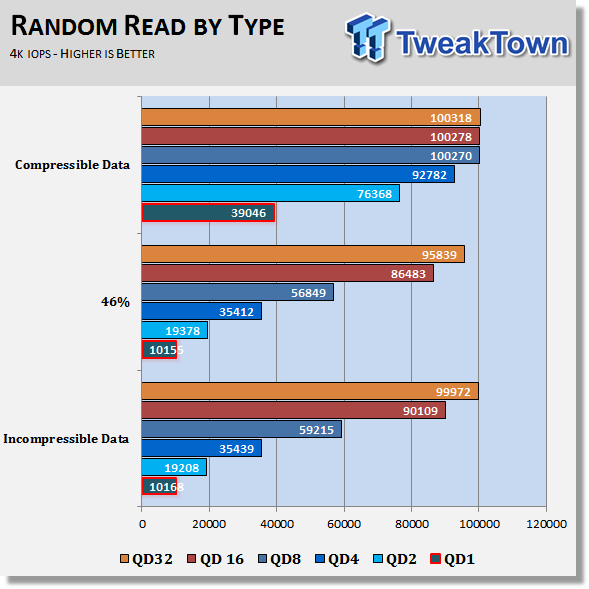
Here we see the same numbers as posted above for the Compressible Data portion at the top of the chart. In the middle, we have a mix of compressible and incompressible data and finally at the bottom we have incompressible data.
What we see here is that the Corsair Neutron XT delivers performance that is competitive with other hyper-class SSDs (currently Samsung's 850 Pro and SanDisk's Extreme PRO) when using incompressible random data and kicks those products ass when using compressible data.
Also noteworthy here is the way the S10 controller performs with a mix of compressible and incompressible data. The 46% mix performance is identical to 100% incompressible performance. This is something we'll have to study more in the future. It will be interesting to read the comments after this review goes live. So many talk down SandForce products for lower incompressible performance.
Low Queue Depth Write IOPS
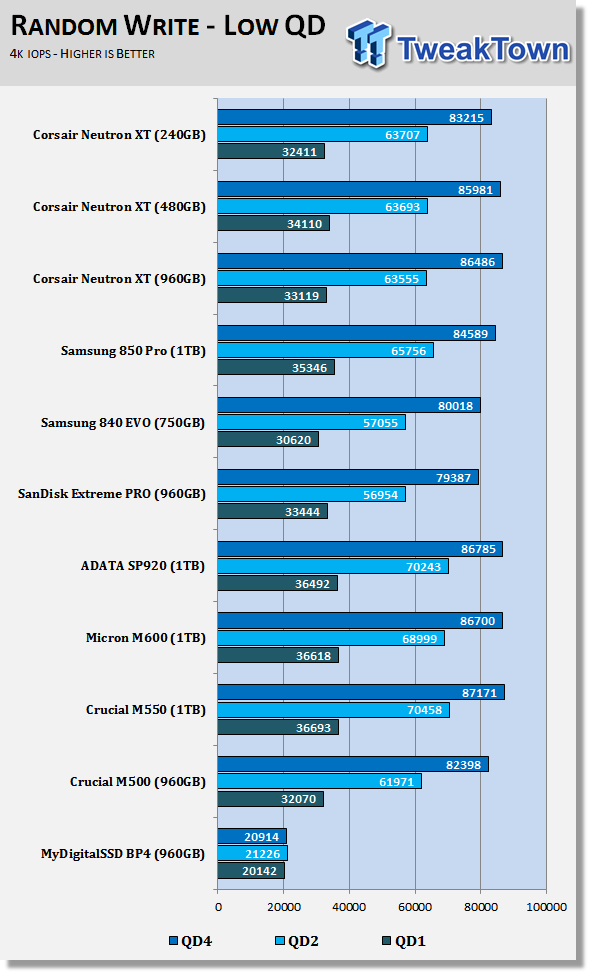
High Queue Depth Write IOPS
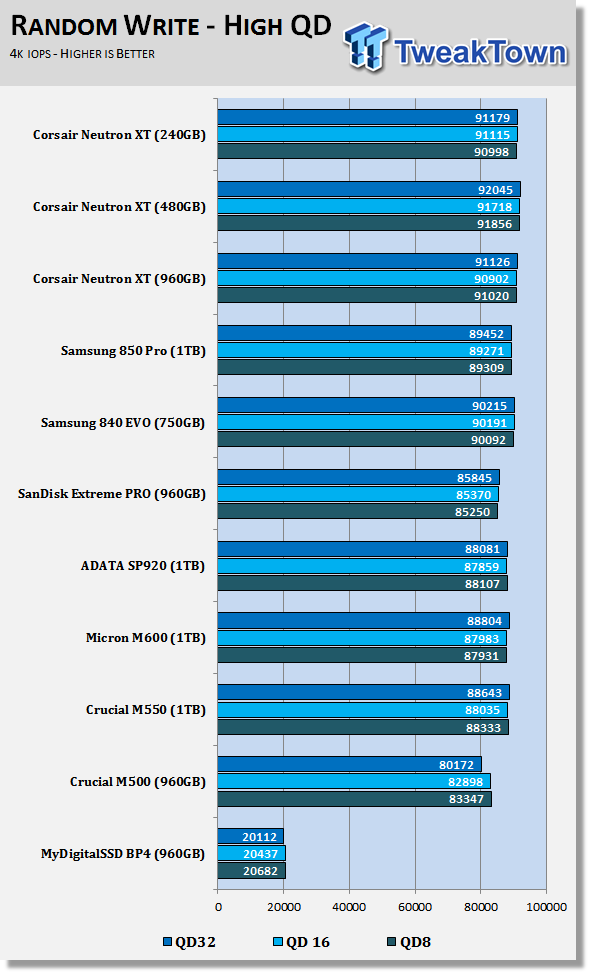
Random write performance isn't affected by data type, but again the Neutron XT delivers high performance. Phison has come a long way with the S10. At the bottom of the chart, we see the random performance from the MyDigitalSSD BP4, a Phison S8 SSD. The Phison S9 is a cache / mainstream performance controller that was never released in a 1TB class product.
Benchmarks - Mixed Read / Write Workloads
Sequential Mixed Read / Write Workloads
In this series of tests, we measure mixed workload performance. We start with 100% read and then add data writes to the mix until we get to 100% writes, in 10% increments. We believe this will be the next major area SSD manufactures will address after performance consistency.
Sequential Mixed Workload Bandwidth
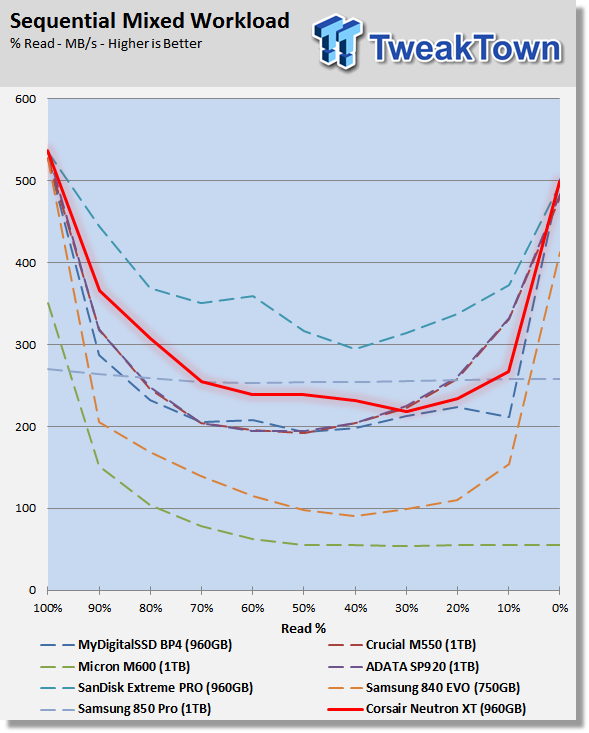
Since SATA drives are not able to read and write from the host at the same time, the drives have to manage requests and prioritize the IO. In the 1TB class of drives, the SanDisk Extreme PRO performs the best across the mix, the Samsung 850 Pro does well in the middle mix, but in heavy reads with light writes, the Corsair Neutron XT comes in just behind the Extreme PRO.
This test uses a 50% mix of compressible and incompressible data so the S10's compressible data magic is ineffective here.
Sequential 80% Read / 20% Write Bandwidth
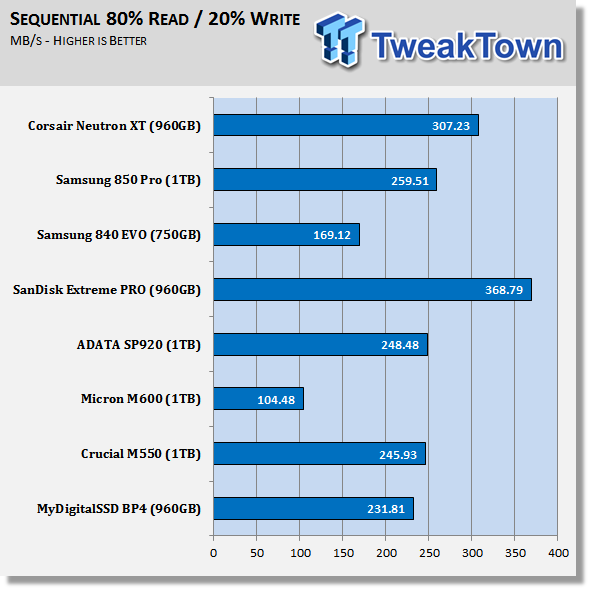
Here we see the 80% read / 20% write mix, the load Intel stated is typical for consumer environments in an older document that discusses the topic in detail.
Random Mixed Workload Response Time
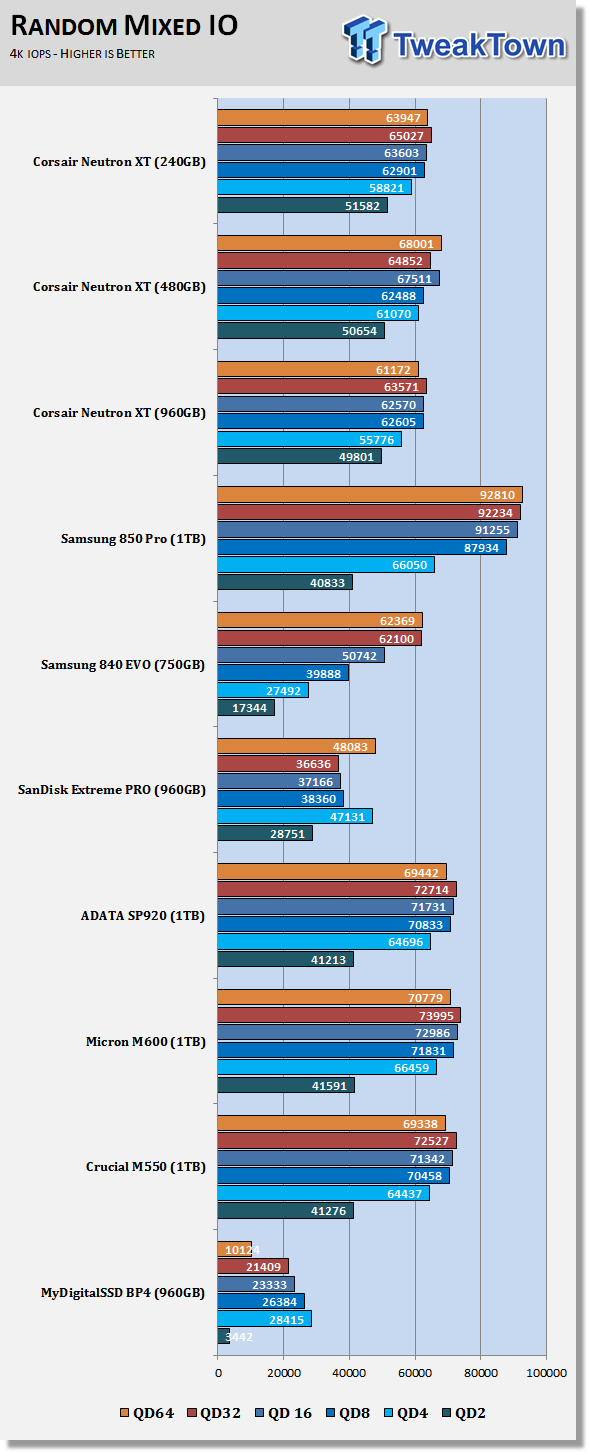
In this test, we look at 50% reads / 50% writes, but with random data at increasing queue depths. What surprises us here is that the Neutron XT does really well in all three capacity sizes. We normally see 240GB drives take a big hit in this test, but not this drive.
PCMark 8 Consistency Test
Futuremark PCMark 8 Extended - Consistency Test
Version and / or Patch Used: 2.0.228
Heavy Usage Model:
Futuremark's PCMark 8 allows us to wear the test drive down to a reasonable consumer steady state and then watch the drive recover on its own through garbage collection. To do that, the drive gets pushed down to steady state with random writes and then idle time between a number of tests allows the drive to recover.
Precondition Phase:
1. Write to the drive sequentially through up to the reported capacity with random data.
2. Write the drive through a second time (to take care of overprovisioning).
Degradation Phase:
1. Run writes of random size between 8*512 and 2048*512 bytes on random offsets for 10 minutes.
2. Run performance test (one pass only).
3. Repeat 1 and 2 for 8 times, and on each pass increase the duration of random writes by 5 minutes.
Steady state Phase:
1. Run writes of random size between 8*512 and 2048*512 bytes on random offsets for 50 minutes.
2. Run performance test (one pass only).
3. Repeat 1 and 2 for 5 times.
Recovery Phase:
1. Idle for 5 minutes.
2. Run performance test (one pass only).
3. Repeat 1 and 2 for 5 times.
PCMark 8's Consistency test provides a ton of data output that we use to judge a drive's performance. Here we see the three states of performance for the select SSDs, light use, consumer steady state and worst case.
Storage Bandwidth - All Tests
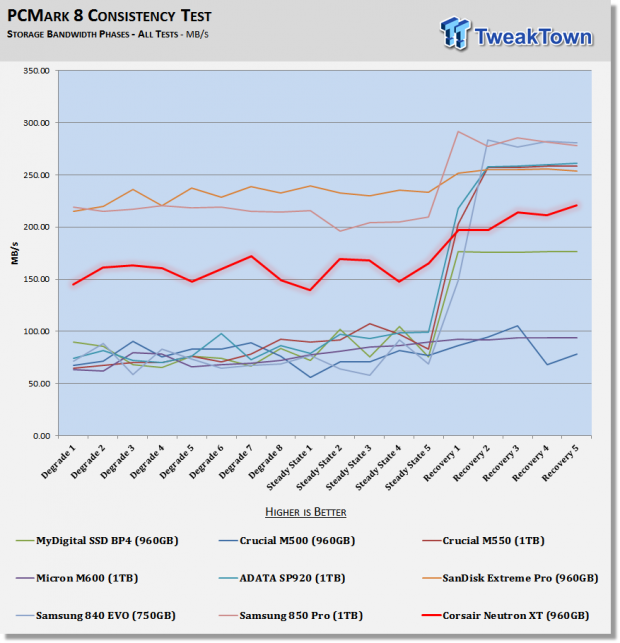
This test uses incompressible data so Phison's compressible performance increase magic is ineffective here.
Storage Bandwidth - Heavy Load
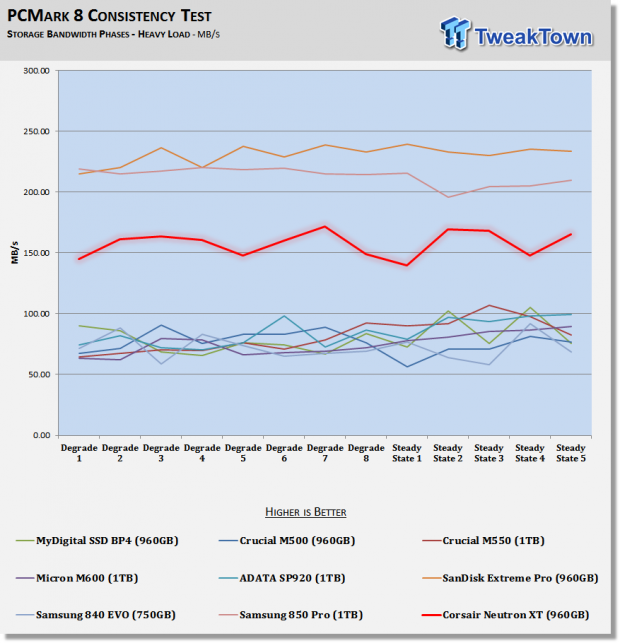
Let's start out with the heavy workload tests with the drives under heavy use. The Neutron XT clearly performs better than a number of products on the market today, but in the same vein, it is clearly a bit slower than the Extreme PRO 960GB and 850 Pro 1TB.
Storage Bandwidth - Typical Consumer Load
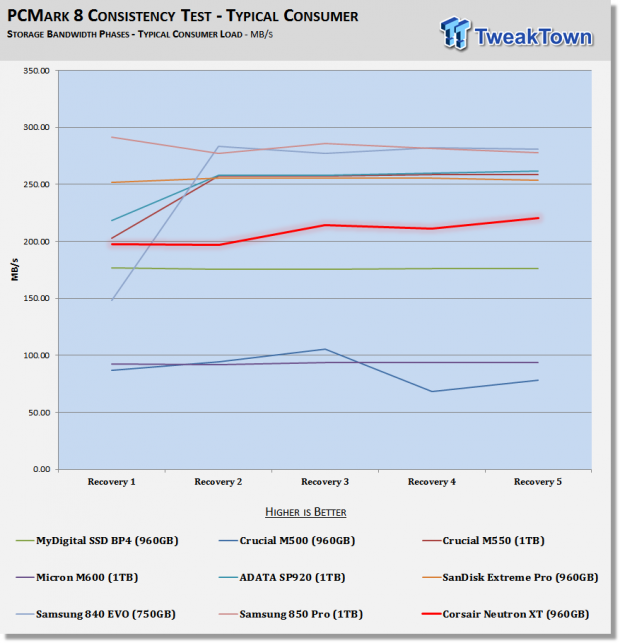
When we move into light use workloads, things change quite a bit. The Extreme PRO and 850 Pro are still at or near the top of the list, but the SLC areas from the flash translation layer allow several of the value SSDs to increase performance to levels higher than the Neutron XT.
FTL SLC area is nearly industry wide with Samsung, SanDisk, OCZ, Toshiba and most recently Micron using the technology. We're surprised Phison didn't use it in some form - it's not like the S10 lacks processing power.
PCMark 8 Consistency Test - Continued
Total Access Time - All Tests
The access time test measures the total latency across all 18 tests. This is one of, if not the most important test we run at this time for consumer SSDs. When your latency is low your computer feels fast, it's just that simple.
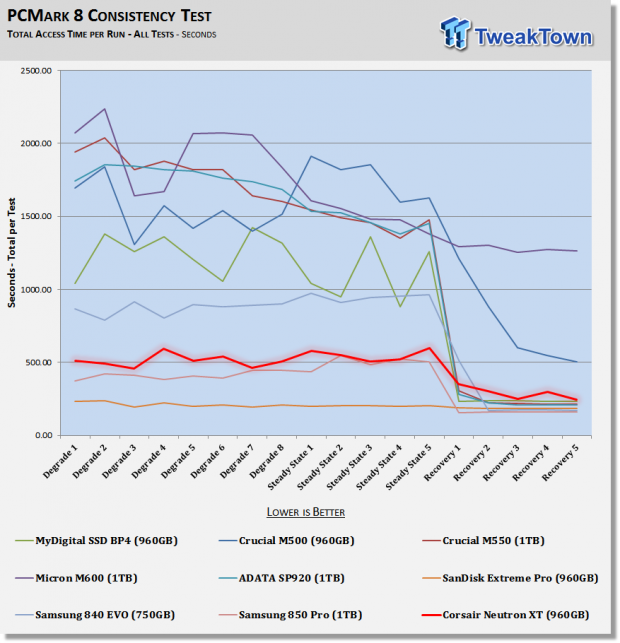
Total Access Time - Heavy Load
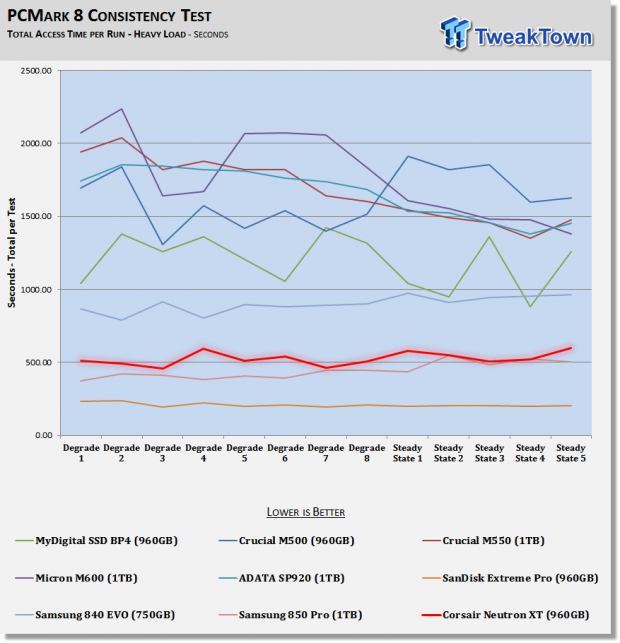
Total Access Time - Typical Consumer Load
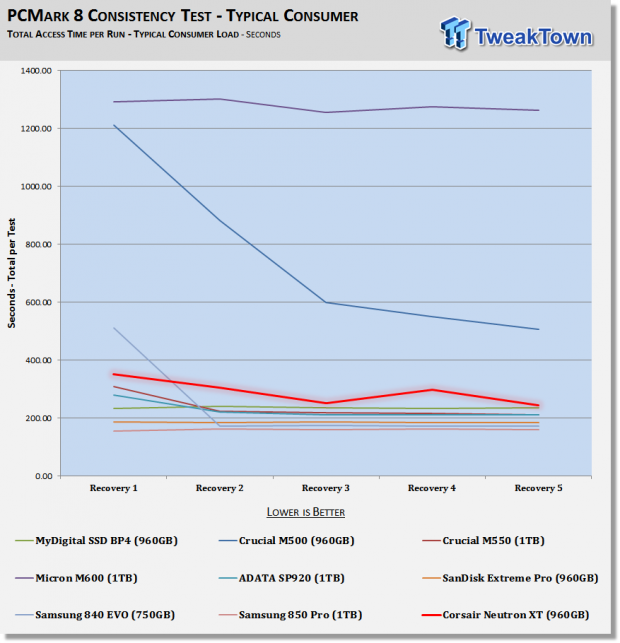
The latency charts show the same as the throughput charts. The Neutron XT 960GB does really well under intense workloads, but cannot take advantage of FTL SLC technology to increase performance when the workload is light.
Again, it should be pointed out this series of tests use incompressible data so some of the controller's performance manipulations are nullified.
Benchmarks - Power Testing
Bapco MobileMark 2012 1.5
Version and / or Patch Used: 2012 1.5
Developer Homepage: http://www.bapco.com
Test Homepage: http://www.bapco.com
MobileMark 2012 1.5 is an application-based benchmark that reflects usage patterns of business users in the areas of office productivity, media creation and media consumption. Unlike benchmarks that only measure battery life, MobileMark 2012 measures battery life and performance simultaneously, showing how well a system design addresses the inherent tradeoffs between performance and power management.
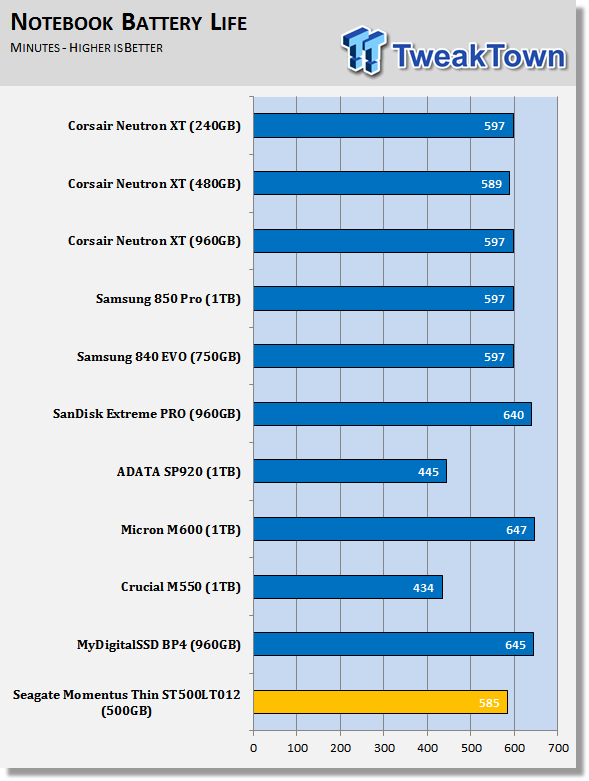
On the product specifications page, we mentioned that Corsair doesn't have DEVSLP / Slumber working yet. The feature reduces the power consumed when the drive is idle.
Even without working DEVSLP, the Neutron XT does remarkably well in our notebook power test. In time, we'll be able to retest these drives with working DEVSLP and we should see the battery time increase by a large amount.
Power Limited Performance
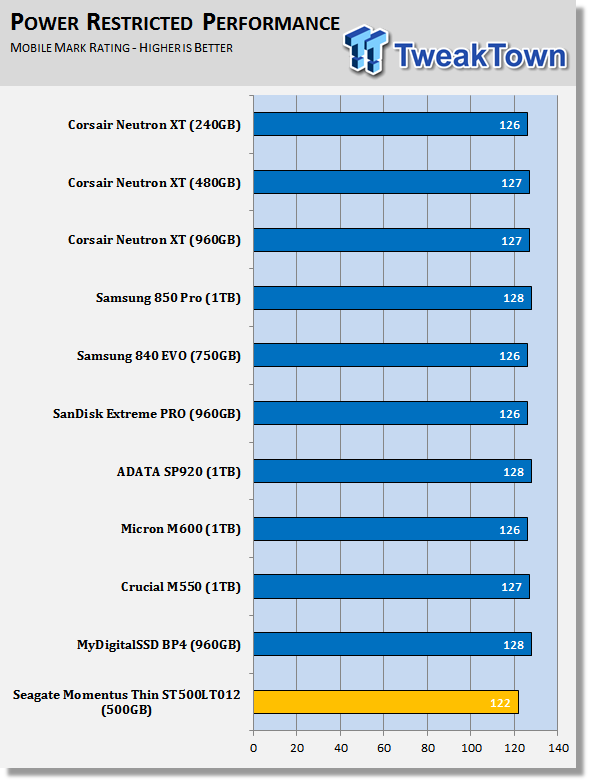
In a notebook's power limited state, the CPU, memory, PCIe bus and SATA bus operate at lower speeds to reduce power. This increases the battery life but also means nearly all SSDs perform at the same performance level. Some drives are special though and are able to perform a little better than others in this limited power environment.
Thermal Testing
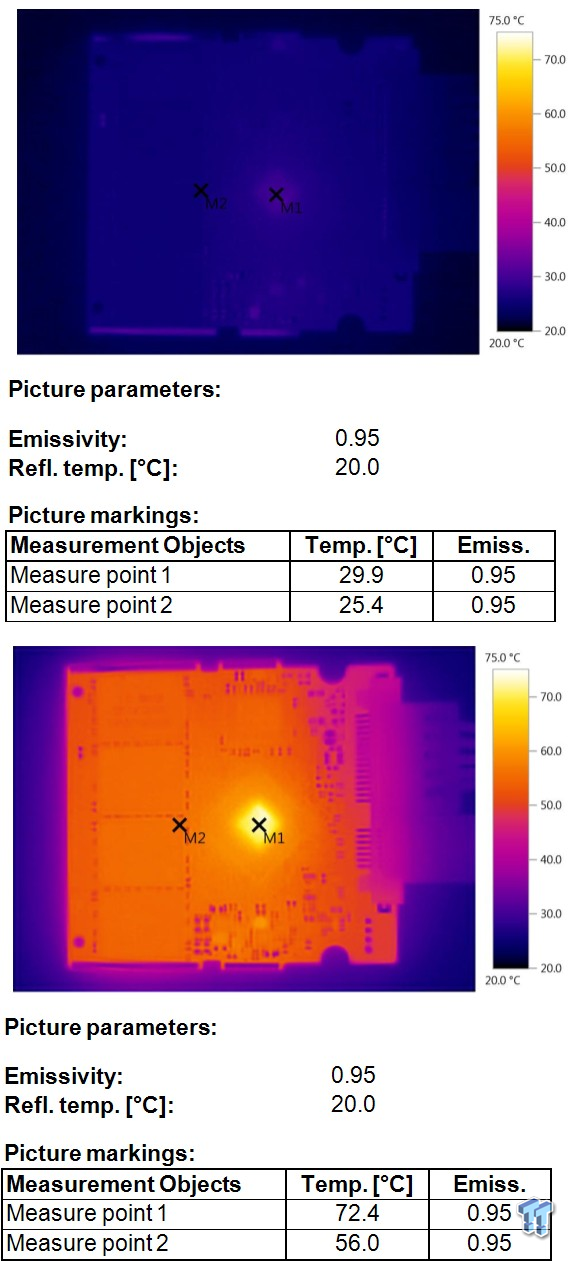
At idle, the Phison S10 controller runs at just 30C. Under a 4K random write load for 15 minutes, the controller temperature increases to 72C without the drive in a case. That is a little higher than some of the other controller we've tested, but quite a bit less than the Samsung XP941 (115C), and the previous Neutron Series (88C).
Final Thoughts
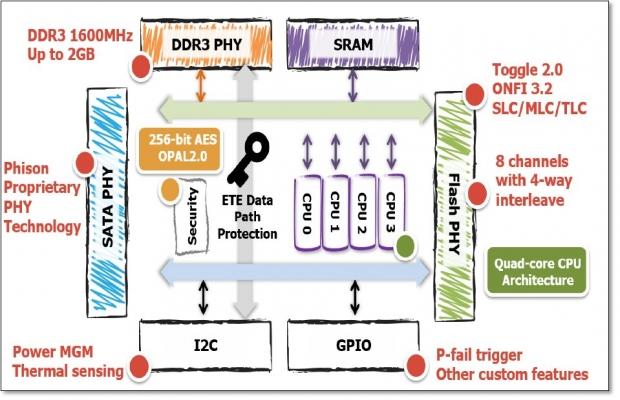
I went back and forth with this preview article, trying to determine if I had enough here to do a full review or to just publish this article in a preview format. At this time not all of the features work (DEVSLP), we don't have a price and hell we don't even have a drive with the right color case. The notebook battery life performance and price weigh heavily in our final scoring breakdown, so we're just going to go the preview route. We'll follow up later with the 240GB and 480GB in review form after we get final notebook battery life performance data as well as confirmation on the MSRP.
Today we glossed over the advanced features, but have a lot more detail to dive into. Next week we'll have a complete deep dive article that breaks down the new Phison S10 controller features. The S10 is a versatile controller that was designed to perform really well with MLC flash, and deliver the endurance required for TLC flash.
We've yet to hear anyone state a price, but the companies we've spoken with who are looking at using the S10 controller all use the same word to describe it: expensive. The controller only makes up a small percentage of the overall product price, a majority of the money is spent on the flash, so if the controller costs a few dollars more than a Marvell, LAMD, SandForce, whatever, it's only a few dollars to the end-user, no big deal.
Our application workload performance measurements show the Neutron XT performing very well under heavy use. At this time, the drive is still a stone's throw away from the Extreme PRO and 850 Pro, but leaps and bounds ahead of drives like the M550, 840 EVO and the small number of legacy drives that can operate with 1TB of flash.
I think the final version of Neutron XT will deliver a bit more performance; there is still some fine tuning left to do. The notebook battery life performance will increase as low power features are ramped up. The Neutron XT drives we tested already do remarkably well in a notebook and we're excited to see the final outcome.
For now, we're going to leave it at that and touch base in the future once we have enough details to roll out a full review.
UPDATE - Corsair has determined that the initial documents for the Neutron XT incorrectly stated a three-year product warranty. The document has been updated to show a five-year warranty. Since this is a preview of the new Neutron XT series, we didn't score the product, but will take another look once the firmware receives an update and we receive MSRP information.

 United
States: Find other tech and computer products like this
over at
United
States: Find other tech and computer products like this
over at  United
Kingdom: Find other tech and computer products like this
over at
United
Kingdom: Find other tech and computer products like this
over at  Australia:
Find other tech and computer products like this over at
Australia:
Find other tech and computer products like this over at  Canada:
Find other tech and computer products like this over at
Canada:
Find other tech and computer products like this over at  Deutschland:
Finde andere Technik- und Computerprodukte wie dieses auf
Deutschland:
Finde andere Technik- und Computerprodukte wie dieses auf